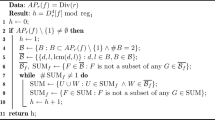Abstract
The control model of rolling of a Riemannian manifold (M; g) onto another one \( \left( {\hat{M},\hat{g}} \right) \) consists of a state space Q of relative orientations (isometric linear maps) between their tangent spaces equipped with a so-called rolling distribution \( {\mathcal D} \) R, which models the natural constraints of no-spinning and no-slipping of the rolling motion. It turns out that the distribution \( {\mathcal D} \) R can be built as a sub-distribution of a so-called no-spinning distribution \( {{\mathcal{D}}_{\overline{\nabla}}} \) on Q that models only the no-spinning constraint of the rolling motion. One is thus motivated to study the control problem associated to \( {{\mathcal{D}}_{\overline{\nabla}}} \) and, in particular, the geometry of \( {{\mathcal{D}}_{\overline{\nabla}}} \) -orbits. Moreover, the definition of \( {{\mathcal{D}}_{\overline{\nabla}}} \) (contrary to the definition of \( {\mathcal D} \) R) makes sense in the general context of vector bundles equipped with linear connections.
The purpose of this paper is to study the distribution \( {{\mathcal{D}}_{\overline{\nabla}}} \) determined by the product connection \( \nabla \times \hat{\nabla} \) on a tensor bundle \( {E^{*}}\otimes \hat{E}\to M\times \hat{M} \) induced by linear connections ∇, \( \hat{\nabla} \) on vector bundles \( E\to M,\,\,\,\hat{E}\to \hat{M} \). We describe completely the orbit structure of \( {{\mathcal{D}}_{\overline{\nabla}}} \) in terms of the holonomy groups of ∇, \( \hat{\nabla} \) and characterize the integral manifolds of it. Moreover, we describe the general formulas for the Lie brackets of vector elds in \( {E^{*}}\otimes \hat{E} \) in terms of \( {{\mathcal{D}}_{\overline{\nabla}}} \) and the vertical tangent distribution of \( {E^{*}}\otimes \hat{E}\to M\times \hat{M} \).
In the particular case of tangent bundles \( TM\to M,\,\,\,T\hat{M}\to \hat{M} \) and Levi-Civita connections, we describe in more detail how \( {{\mathcal{D}}_{\overline{\nabla}}} \) is related to the above mentioned rolling model, where these Lie brackets formulas provide an important tool for the study of controllability of the related control system.
Similar content being viewed by others
References
F. Alouges, Y. Chitour, R. Long. A motion planning algorithm for the rolling-body problem. IEEE Trans. on Robotics (2010).
A. Agrachev, Y. Sachkov. An Intrinsic approach to the control of rolling bodies. In: Proc. Conf. Decision and Control, Phoenix (1999), Vol. 1, pp. 431-435.
A. Agrachev, Y. Sachkov. Control theory from the geometric viewpoint. Encyclopaedia Math. Sci., 87. Control theory and optimization, II. Springer-Verlag, Berlin (2004).
Y. Chitour, P. Kokkonen. Rolling manifolds: intrinsic formulation and controllability. Preprint, arXiv:1011.2925v2 (2011).
Y. Chitour, P. Kokkonen. Rolling manifolds and controllability: the 3D case. Submitted (2011).
Y. Chitour, P. Kokkonen. Rolling manifolds on space forms. Submitted (2011).
M. Godoy Molina, E. Grong, I. Markina, F. Leite. An intrinsic formulation of the rolling manifolds problem. arXiv:1008.1856v1 (2010).
E. Grong. Controllability of rolling without twisting or slipping in higher dimensions. arXiv:1103.5258v2 (2011).
S. Helgason. Dierential geometry, Lie groups and symmetric spaces. Pure Appl. Math., 80. Academic Press, Inc., New York-London (1978).
D. D. Joyce. Riemannian holonomy groups and calibrated geometry. Oxford University Press (2007).
S. Kobayashi, K. Nomizu. Foundations of dierential geometry. Wiley-Interscience (1996), Vol. I.
A. Marigo and A. Bicchi. Rolling bodies with regular surface: controllability theory and applications. IEEE Trans. Automat. Control 45 (2000), No. 9, 1586-1599.
R. Montgomery. A tour of subriemannian geometries, their geodesics and applications. AMS (2006).
T. Sakai. Riemannian geometry. Transl. Math. Monogr., 149. Amer. Math. Soc., Providence, RI (1996).
R.W. Sharpe. Dierential geometry: Cartan’s generalization of Klein’s Erlangen program. Grad. Texts Math., 166. Springer-Verlag, New York (1997).
Author information
Authors and Affiliations
Corresponding author
Rights and permissions
About this article
Cite this article
Kokkonen, P. Rolling of manifolds without spinning. J Dyn Control Syst 19, 123–156 (2013). https://doi.org/10.1007/s10883-013-9167-6
Received:
Revised:
Published:
Issue Date:
DOI: https://doi.org/10.1007/s10883-013-9167-6




